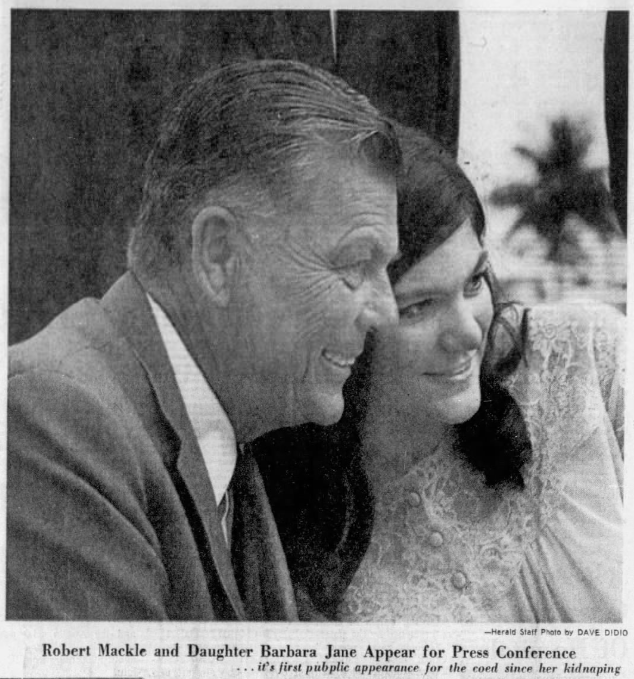Barbara Mackle: The Story Of Survival And Courage
Barbara Mackle's name became a household topic during one of the most sensational kidnappings in American history. Her story is not just about abduction but also about resilience, survival, and the unwavering strength of the human spirit. As we delve into her remarkable journey, we uncover the events that captured the nation's attention and left an indelible mark on history.
Her case became a defining moment in the annals of crime and justice. It highlighted the vulnerabilities of society at the time and the lengths to which individuals would go to seek ransom and fame. Barbara Mackle's experience serves as both a cautionary tale and an inspiring narrative of triumph over adversity.
In this article, we will explore the details of Barbara Mackle's kidnapping, her eventual rescue, and how her life unfolded afterward. We will also examine the broader implications of her case, including the psychological impact on victims of similar crimes and the measures implemented to prevent future incidents. Join us as we uncover the life and legacy of Barbara Mackle.
Read also:Bryan Adams Current Partner A Deep Dive Into His Love Life
Table of Contents
- Biography of Barbara Mackle
- Details of the Kidnapping
- The Rescue Operation
- Media Coverage and Public Reaction
- Psychological Effects on Barbara Mackle
- Legal Proceedings and Outcomes
- Prevention Efforts in the Wake of the Case
- Long-Term Impact on Society
- Barbara Mackle's Life Afterward
- Conclusion
Biography of Barbara Mackle
Early Life and Background
Barbara Mackle was born on January 24, 1947, in Atlanta, Georgia. She grew up in a privileged family, with her father, Edward Mackle Jr., being the president of Atlantic Ice & Coal Company. Her affluent upbringing made her a target for those seeking financial gain through criminal activities. Below is a summary of her early life:
| Full Name | Barbara Jane Mackle |
|---|---|
| Date of Birth | January 24, 1947 |
| Place of Birth | Atlanta, Georgia |
| Family Background | Wealthy family involved in the coal and ice industry |
| Education | Attended Agnes Scott College |
Details of the Kidnapping
The Abduction Process
Barbara Mackle's kidnapping occurred on December 13, 1968. The kidnappers, Gary Steven Krist and Ruth Eisemann-Schier, devised a meticulous plan to abduct her during her Christmas break from Agnes Scott College. The duo chose Barbara due to her family's wealth, believing it would ensure a substantial ransom.
According to FBI reports, the kidnappers lured Barbara into their car under the pretense of a fake car breakdown. They then transported her to a secluded cabin in the woods near Atlanta, where they buried her in a plywood box underground. The box was equipped with air holes and a small amount of food and water, highlighting the kidnappers' calculated approach to keeping her alive until the ransom was paid.
The Rescue Operation
Law Enforcement Involvement
The FBI played a pivotal role in Barbara Mackle's rescue. Upon receiving the ransom demand of $500,000, the Mackle family cooperated fully with authorities. The FBI tracked the kidnappers' movements using a combination of surveillance and informants, eventually narrowing down their location.
On December 24, 1968, law enforcement officers discovered Barbara's burial site after following a tip-off. Despite the harsh conditions and limited resources, Barbara was found alive and subsequently rescued. This marked a significant victory for law enforcement and brought immense relief to the Mackle family and the public.
Media Coverage and Public Reaction
The Nation's Attention
The Barbara Mackle kidnapping dominated headlines across the United States. Newspapers, television networks, and radio stations extensively covered the case, capturing the public's imagination and concern. The media's portrayal of Barbara as a victim of circumstance humanized her story and rallied support for her safe return.
Read also:What Were The Teenage Mutant Ninja Turtles Names A Comprehensive Dive
- Major news outlets provided daily updates on the investigation.
- Public interest peaked during the ransom negotiations and eventual rescue.
- Her case underscored the importance of media in amplifying high-profile criminal cases.
Psychological Effects on Barbara Mackle
Impact of Trauma
Barbara Mackle's ordeal left a lasting impact on her mental health. Being confined in a small box underground for ten days exposed her to extreme psychological stress. Experts have noted that such experiences can lead to post-traumatic stress disorder (PTSD) and other anxiety-related conditions.
Research indicates that victims of kidnappings often require extensive counseling and support to overcome the trauma. Barbara reportedly underwent therapy to address the emotional scars of her experience, demonstrating the necessity of long-term care for survivors of such crimes.
Legal Proceedings and Outcomes
Justice Served
The legal proceedings against Gary Steven Krist and Ruth Eisemann-Schier were swift and decisive. Both were apprehended shortly after Barbara's rescue. Krist was sentenced to life imprisonment, while Eisemann-Schier received a lesser sentence due to her cooperation with authorities.
This case set a precedent for the prosecution of kidnappers and reinforced the importance of stringent penalties for such crimes. It also highlighted the effectiveness of law enforcement collaboration in resolving high-profile cases.
Prevention Efforts in the Wake of the Case
Enhancing Safety Measures
In response to Barbara Mackle's kidnapping, significant efforts were made to enhance public safety. Law enforcement agencies improved their protocols for handling kidnappings, incorporating advanced technology and training. Additionally, public awareness campaigns were launched to educate citizens on recognizing and reporting suspicious activities.
- Increased funding for FBI operations targeting kidnappers.
- Development of community alert systems to quickly disseminate information.
- Improved coordination between local and federal law enforcement agencies.
Long-Term Impact on Society
Changing Perceptions
The Barbara Mackle case had a profound effect on societal perceptions of crime and justice. It underscored the vulnerability of individuals, even those from affluent backgrounds, to criminal acts. Moreover, it prompted discussions on the need for stricter laws and more effective law enforcement strategies.
Studies conducted in the years following the case revealed a growing awareness of the risks associated with kidnapping and the importance of preventive measures. This shift in public consciousness contributed to a more vigilant society.
Barbara Mackle's Life Afterward
A Life of Resilience
After her harrowing experience, Barbara Mackle chose to focus on rebuilding her life. She continued her education and eventually pursued a career in teaching, dedicating herself to helping others. Her story of survival inspired countless individuals facing their own adversities.
In interviews, Barbara expressed gratitude for the support she received from her family and the public. Her ability to overcome trauma and lead a fulfilling life serves as a testament to her strength and resilience.
Conclusion
Barbara Mackle's kidnapping remains one of the most infamous criminal cases in American history. Her story is a powerful reminder of the resilience of the human spirit and the importance of justice and safety in society. Through her ordeal, we have learned valuable lessons about crime prevention, the psychological impact on victims, and the role of media in shaping public perception.
We invite you to share your thoughts on Barbara Mackle's story in the comments section below. Additionally, consider exploring other articles on our site that delve into similar topics of crime, justice, and human resilience. Together, let's continue the conversation and strive for a safer world.


